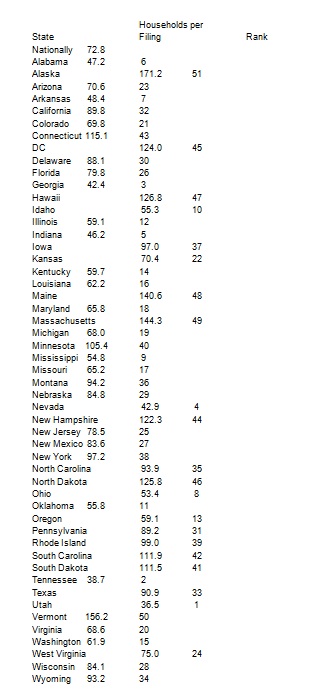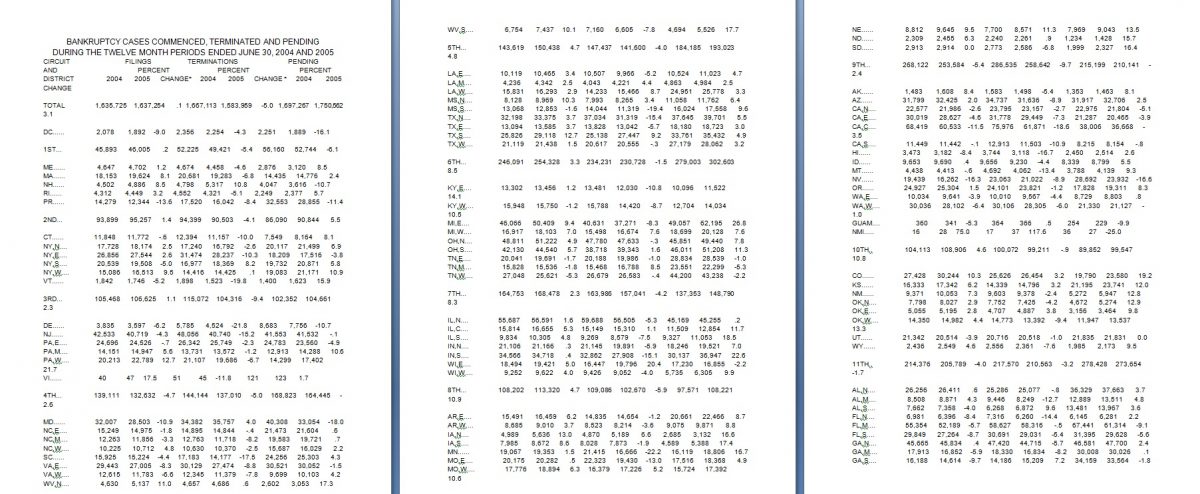Introduction
Bankruptcy law draws upon a blend of principles, some of which are referable to the general approach to be followed in cases of bankruptcy, while others address the special questions that result from the domestic dimension within the instant case. Despite the wide variation between legal systems in terms of policy and approach towards bankruptcy, extending across the gamut from pro-debtor to pro-creditor, at least one fundamental principle appears to command universal acceptance (although the exact circumstances and mode of its application can vary). recent years, there is an increasing number of bankruptcy cases in the USA caused by changes in laws and regulations, economic and political issues.
Main Text
Bankruptcy is defined as “settlement of the liabilities of a person or organization wholly or partially unable to meet financial obligations. The purposes are to distribute, through a court-appointed receiver, the bankrupt’s assets equitably among creditors and, in most instances, to discharge the debtor from further liability” (The Columbia Encyclopedia 4179). The bankruptcy involves the following: individual bankruptcy, municipal bankruptcy; rehabilitation or reorganization, rehabilitation for family farmers and fishermen, rehabilitation with a payment plan for individuals. The bankruptcy procedure can be voluntary or involuntary. The main types of bankruptcies are liquidation and reorganization. During liquidation procedures (Chapter 7 in Bankruptcy Code), some of the property is sold in order to pay debts and cover expenses. During reorganization (Chapter 11 in Bankruptcy Code), debts are paid over time from income (Elias 5-6). A term bankruptcy may be termed ‘the principle of collectivity’, and amounts to a recognition that bankruptcy constitutes an example of the so-called ‘common pool problem’, which arises whenever conditions are such that more than one person has rights over the same, finite fund of resources.
“On April 20, 2005, President Bush signed into law the Bankruptcy Abuse Prevention and Consumer Protection Act of 2005 (“BAPCPA”). BAPCPA made substantial changes to the Bankruptcy Code. And the Bankruptcy Judges Division has made significant revisions to this online version of Bankruptcy Basics to account for BAPCPA’s changes to the Code” (United States Bankruptcy Courts 2008; See appendix 1). By regarding all those with claims against the debtor as members of a collectivised entity, the law transforms what were originally multiple relationships between each creditor and the debtor into a unified whole for the purpose of administering and distributing such value as remains in the debtor’s estate. An important aspect of the concept of collectivity is the pari passu principle of distribution, whereby all debts of equivalent rank are subject to an arithmetical process of abatement, based upon the relative proportions of the collective mass of claims belonging to that ranking class, and the total size of the fund available to pay those claims: the dividend payable to the holder of each separate claim is then calculated on a pro rata basis, applying this proportional formula, so that the scale of abatement is identical in every case (The American Bar Association 75).
According to statistics, in 2005 year the number of bankruptcies increased in 10%. “During the 12-month period ending September 30, 2005, 1,782,643 bankruptcies were filed, up from the 1,618,987 bankruptcy cases filed in fiscal year 2004” (United States Bankruptcy Courts 2008; see Appendix 2,6). Because of their collective and comprehensive character, and also because of their potential consequences in terms of the legal status of the debtor, they must be regarded as fundamentally different to the orthodox types of civil or commercial litigation pursued on a party-to-party basis. “Business bankruptcies for FY 2005 fell 2 percent to 34,222, from the 34,817 business bankruptcies filed in FY 2004. Non-business or personal bankruptcies rose 10 percent in FY 2005, to total 1,748,421, up from 1,584,170 in FY 2004” (United States Bankruptcy Courts 2008; see Appendix 3, 4. 5). It is appropriate, therefore, to assess the principles for exercise of bankruptcy jurisdiction in an independent manner, without necessarily adopting any rule or policy from the realm of general litigation unless it can withstand further scrutiny under the more exacting standards that should attend the operation of bankruptcy jurisdiction in a domestic context (see Appendix 7, ).
From the standpoint of private law, the issues of principal interest in relation to personal bankruptcy are: (1) Jurisdiction–under what circumstances can bankruptcy proceedings take place in a given jurisdiction, in relation to a given debtor? (2) Enternational Effects of Bankruptcy–the extent to which a bankruptcy adjudication is capable of taking effect in relation to property of the debtor situate in foreign jurisdictions outside the forum of bankruptcy; (3) Choice of Law–the principles to be applied in determining the governing law for the main process of the bankruptcy itself, and in resolving subsidiary or incidental questions arising in the context of the main proceedings, and affecting claims or parties in interest; (4) Treatment of Creditors and Claims in the bankruptcy process.
American bankruptcy law provides for both voluntary and involuntary proceedings, in the case of both liquidation proceedings, under Chapter 7 of the Code, and reorganisation proceedings under Chapter 11. One structural feature which differentiates the American system of bankruptcy from the approaches followed by Australia, Canada and England is that the procedures under Chapters 7 and 11 are applicable to all types of eligible debtor, irrespective of whether the debtor is an individual or a corporation. A voluntary filing (which is by far the most common circumstance) may be initiated at any time by the debtor without the need to satisfy any financial test to establish a state of current or prospective bankruptcy (The American Bar Association 77).
No adjudication is necessary, although the act of filing places the debtor and his estate under the regime of the bankruptcy law, and the control and supervision of the bankruptcy court is a prominent feature of the ensuing process. An involuntary proceeding may be commenced by any creditor except one whose claim is contingent (in the sense that it is dependent upon an event which is not certain to occur), or whose claim is bona fide disputed. A petition may be presented by one or more creditors, but if the debtor has more than eleven creditors (excluding certain connected persons or employees), Bankruptcy law requires that a minimum of three must join in the petition. In every case, the total amount owed to the petitioning creditor(s) must be at least $5,000 over and above the value of any security they hold. Finally, there must be evidence of a need for bankruptcy proceedings, either because the debtor is generally not paying his debts as they become due, or because a general assignee for the benefit of creditors or a general receiver has taken charge of the debtor’s property within the previous 120 days (Brubaker 743; The American Bar Association 82).
For instance, the case CELOTEX CORP. v. EDWARDS (1995) established that “respondents must obey the Bankruptcy Court’s injunction as persons are subject to an injunctive order” (Selected U.S. Supreme Court Bankruptcy Decisions 2008). THINGS REMEMBERED, INC. v. PETRARCA (1995) accepted that “If an order remands a removed bankruptcy case to state court because of a timely raised defect in removal procedure or lack of subject-matter jurisdiction, a court of appeals lacks jurisdiction to review the order under” (Selected U.S. Supreme Court Bankruptcy Decisions 2008). Because of the inherent differences between legal and natural persons, it is only to be expected that numerous distinctions have arisen in the course of time with respect to the legal and procedural regimes that are applicable in the event of bankruptcy. ‘Corporation’ is the formal term used by law to designate an entity on which legal personality is conferred such as to be separate from the individuals comprising it.
As a legal–or juristic–person a corporation is capable of enjoying and being subject to legal rights, duties and liabilities, and also enjoys the character of perpetuity, in the sense that its existence is maintained through the succession of new individuals as members in place of those who die or are removed. Unlike human beings, whose legal personality is inherent and not dependent on any special process of the law itself, a corporation can only exist as a legal person through having undergone a requisite process of formation whereby such grant of a legal persona took effect. Law distinguishes between two types of corporation, the ‘corporation sole’, consisting of one member only at any one time, and the ‘corporation aggregate’, which may consist of several or many members contemporaneously whose individual identities can fluctuate over time. It is to the latter category that the type of entity which concerns us here–the joint stock company, formed through a process of registration under the Companies Acts–belongs. The United States Bankruptcy Code does not adopt the distinction between individual and corporate debtors (The American Bar Association 101).
Such cases as Nobelman v. American Savings Ban (1993), In re Anderson, (1994), In re Mendoza (1997), In re Slyman (2000) portray that courts are likely to be more receptive to arguments in favor of jurisdictional abstention where they can be convinced that the utilization of bankruptcy law amounts to an abuse of legal process, either on the part of a creditor seeking to harass or oppress the debtor, or by the debtor who is perhaps hoping that a adjudication, followed by discharge, may somehow serve as a barrier to immunize his future property from being seized by or on behalf of unpaid creditors whose claims are comprised in foreign bankruptcy proceedings from which the debtor remains undischarged (The American Bar Association 92). In re Kong (1999) and In re Hoggle, (1994) prove that while necessarily keeping in mind that one of the accepted purposes of individual law is to provide a controlled regime whereby a debtor may be freed from the burden of debt, and gain a fresh start for the future, courts must be ever-vigilant to the possibility that some debtors may take advantage of the law’s beneficent policy, by exploiting the protective facilities of a statutory moratorium and subsequent discharge in such a way as to perpetrate fraud on their creditors (The American Bar Association 92).
Moreover, it may be observed that the court is furnished with no assistance in the event of a need to priorities as between different factors, to the extent that it may not prove possible to fulfill all the criteria simultaneously in the context of a given case. The drafting of the subsection also gives rise to some difficulty in this respect, because the use of the single linking word ‘and’ after the penultimate paragraph (5), may be interpreted as imposing a requirement in every instance that all the first five criteria must be fully met (and also the sixth criterion, where this is ‘appropriate’). Such a task may well prove impossible to accomplish under the circumstances of some cases, and in the fight of the current diversity between the various national bankruptcy laws (Elias 11).
Ultimately, the successful application of the ambitious terms of Chapters 7-13 as a whole is dependent upon the good sense of the court in charting a path that amounts to a reasonable and defensible exercise of discretion under conditions so infinitely variable as to defy the possibility of comprehensive legislative prescription. If the assets and interests of the debtor are located in several American judicial districts, the operation could be rendered more costly and complex if it were necessary to file multiple applications, treating each district as a separate entity (Elias 16).
In Evans v. Hancock, Rothert & Bunshoft (In re Evans) the Bankruptcy Court of the Southern District of New York held that to oblige a foreign representative to file separate ancillary proceedings in each district where property is located, or where an injunction is sought, would defeat the objective of section 304 of the Bankruptcy Code to facilitate the economical and expeditious administration of the estate, and would result in a ‘procedural nightmare’. The court concluded that it is sufficient for the foreign representative to commence ancillary proceedings in the district where the debtor’s principal place of business or principal assets are located, and that turnover and injunctive orders may thereafter be sought from the court of that district, regardless of the location of the assets in question (The American Bar Association 72). The good sense of granting such nationwide injunctions, to avoid piecemeal litigation over the foreign debtor’s assets dispersed across the USA, is readily apparent. In granting such relief, the court is likely to require verification that all parties in interest in any pending actions anywhere within the USA have received adequate notice of the proceedings (The American Bar Association 71).
Conclusion
In sum, alongside the numerous innovations to the domestic bankruptcy law of the USA, the provisions contained in Chapters 7-13 can be credited with having brought about a transformation of the American approach in the field of bankruptcy that is little short of revolutionary. Indeed, the section still represents a benchmark in terms of the liberal, universalist approach to the problems posed by multi-jurisdictional bankruptcies. Although its provisions, and the manner in which they have sometimes been judicially interpreted and applied, have not entirely escaped critical censure, there is a broad consensus of scholarly acclaim for their inspired vision.
Works Cited
The American Bar Association Guide to Credit and Bankruptcy: Everything You Need to Know About the Law, Your Rights, and Credit, Debt, and Bankruptcy. American Bar Association. (Author) Random House Reference, 2006.
Bankruptcy. The Columbia Encyclopedia, Sixth Edition, 2007, p. 4179.
Brubaker, R. On the Nature of Federal Bankruptcy Jurisdiction: A General Statutory and Constitutional Theory. William and Mary Law Review, 41 (2000): 743-747.
Elias, S. The New Bankruptcy: Will It Work for You? NOLO; 2nd edition, 2007.
Selected U.S. Supreme Court Bankruptcy Decisions. 2008. Web.
United States Bankruptcy Courts. 2008. Web.
Appendix
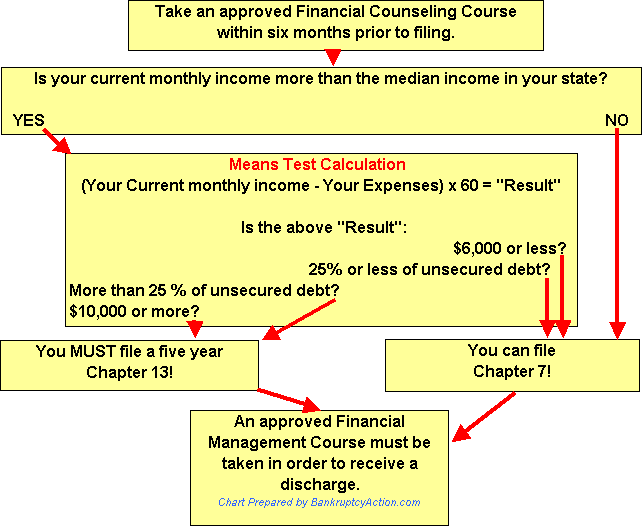
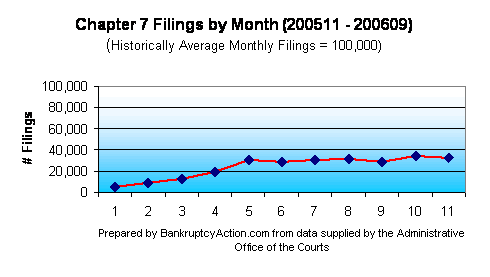
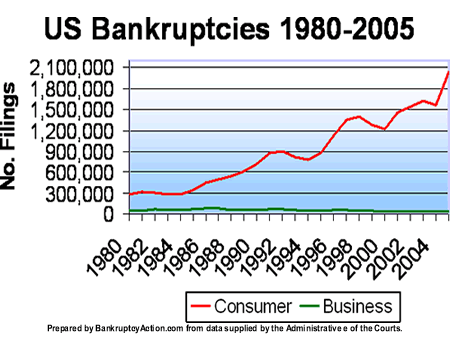
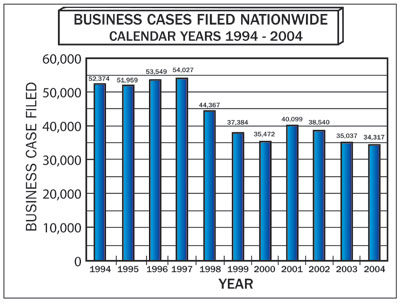

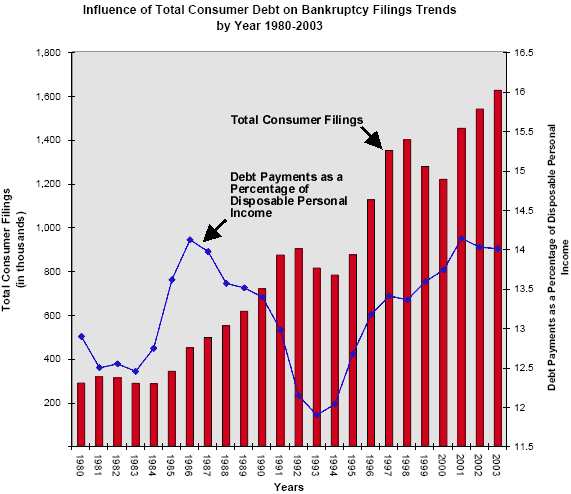
Households Per Filing, Rank.
During the 12-Month Period Ending March 31, 2004.
